Review: Underwater Photography Masterclass by Alex Mustard
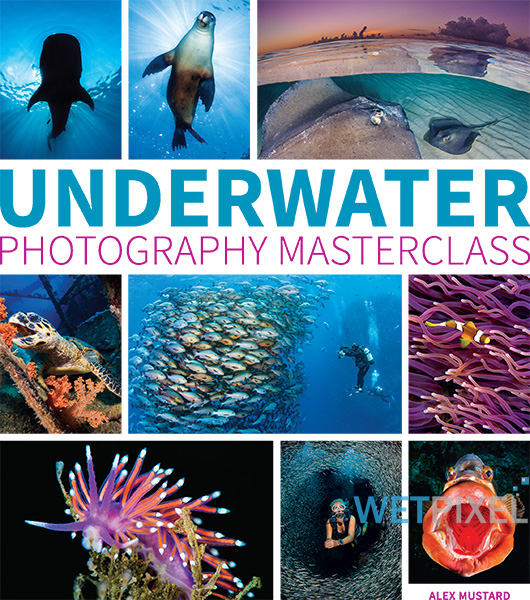
Alex Mustard has been involved in creating underwater images for over 30 years and has been doing so full time for the last 10. His imagery has won many of the major wildlife photography competitions worldwide and for many years his willingness to share his techniques as an Associate Editor of Wetpixel has provided people with the knowledge to fulfill their photographic goals.
He has been running popular photographic workshops for some time, some in conjunction with Wetpixel. The workshop participants universally acknowledge how much Alex’s experience and knowledge has helped them to enhance their photographic abilities. In addition, Alex has the ability to present complex subjects in a manner that allows them to be used practically. He has a knack of showing people why things work, which then allows them to apply these ideas to real life shooting.
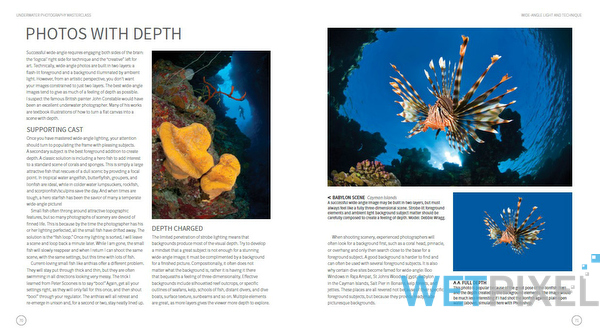
Alex has authored several books, but the Underwater Photography Masterclass is his first instructional one. It is a repository of a vast number of technique and ideas couched in terms that, like his workshops, attempt to not only provide practical suggestions, but also to help the user to understand why the techniques work. It has over 190 pages and is profusely decorated with color illustrations. I am aware that publishing constraints forced Alex to be very selective with his choices of both words and pictures and as a result the book is literally jam packed with information. Quite simply, there is no other underwater photography text in print that deals with as many ideas and techniques as this one.
One of the first things that I do when asked to review photographic text books, is to check out the way the book handles using ISO as an exposure control. Many well-known, experienced and very talented underwater photographers (who often originally started shooting in the film era), seem to not be aware of its significance with modern cameras and simply do not mention it. Fundamentally, it is hard to see how they then can then talk about maximizing corner sharpness with full frame cameras for example.

The Underwater Photography Masterclass is right up to date and as you might expect, ISO is seen very much as a “third” exposure control and it is used as such. Other examples of “recent” topics include off-camera lighting, the use of snoots, inward and cross lighting techniques as well as super macro using diopters, extension tubes and teleconverters. Perhaps not all of these ideas are new but have been reinterpreted recently and for the first time this book actually shows how to use them in a modern idiom.
It is good to see some specific guidelines on how to use post processing tools with reference to specific types of underwater image. Alex talks about Adobe Lightroom and Photoshop (in their current CC versions), with a very useful summary of backscatter removal techniques using the latter. Again, a common failing of many instructional books is to ignore post processing or talk about using software that is either out of date or not particularly widely used anymore. A pet peeve of mine are books that suggest that underwater photographers should use “entry level” software. Given the expense of camera, housing and strobes, not to mention travel to an exotic location, the additional cost of using up to date and fully featured programs seems pretty insignificant.
There is a lot of information in this book and attempting to read it from cover to cover is perhaps not the best way to interact with it. Breaking the learning into small, immediately relevant sections will make both retention and understanding much easier. Alex describes his desired interaction as; “work through it slowly and grow with over time”, and I think this is an important consideration. The book is more tutorial than reference and like any tutorial, the reader should try to incorporate some practical exercises too. I think it should be read with your cameras and/or housing in your lap or on the side of the pool. When a particular strobe position is mentioned, move your strobes into that position and so forth
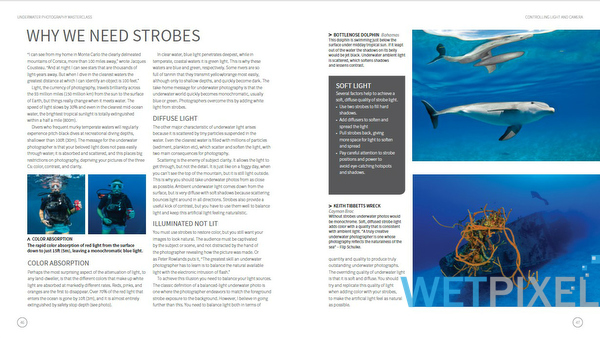
Throughout the book, there are quotes from eminent photographers and individuals (including Baldrick from the BBC’s Blackadder series), as well as suggestions of other photographers whose techniques exemplify particular concepts and are worth exploring to enhance understanding. It also has a bibliography providing some possible sources of further information or inspiration.
He divides cameras into four broad types, full frame SLR, cropped sensor SLR, mirrorless and compact and gives pretty equal treatment to all four flavors. If there is a bias, it is towards SLR cameras which is perhaps inevitable given that Alex shoots with one. I think Alex is careful to avoid expressing a preference in terms of equipment, but quite rightly stresses that all cameras and underwater set ups are capable of producing stunning imagery, if they are employed in a way that maximizes their potential. Of course, he then goes on to give concrete steps as to how to do this. Given the space constraints, he does a very good job of describing the key differences in how different cameras would be set up to shoot a particular scene, including settings and (where appropriate) lens choices.
A primary focus of the book is to improve lighting; not only in terms of correctly exposing subjects, but also getting the best quality of light onto them. Quite often, this involves distributing strobes in different positions. The book utilizes photo illustrations showing the strobe positions, but I felt that line diagrams would help my easily befuddled mind. As mentioned above, I would strongly recommend physically practicing with strobe positions whilst reading too.
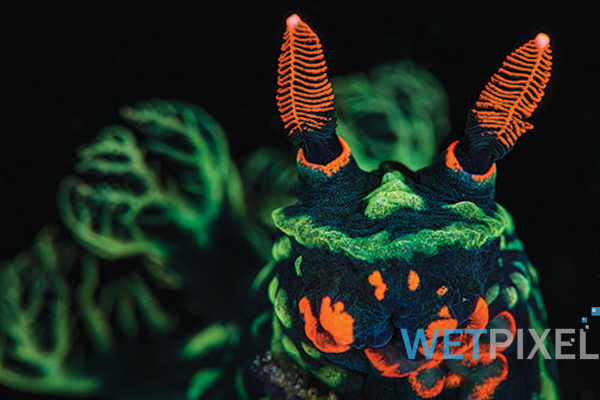
I am not convinced that this is an ideal book for people taking their first images underwater. It will provide lots of inspiration, but the level of technical advice may be somewhat daunting and to be blunt, over the top. However, for the photographer who has been diving with a camera for a while or is serious about taking pictures underwater, it is a game changer. People sometimes describe books like this as being good for those in a creative rut however, I am convinced that this book will enhance anyone’s ability. Simply put, if you are an underwater photographer and do not find techniques and ideas in this book that excite, stimulate and challenge you to try something new, you are very jaded indeed!
It is impossible not to compare this book with Martin Edge’s “The Underwater Photographer”. My opinion is that the two books are different and complimentary. Alex’s book provides pretty detailed instructions for a series of techniques, whereas Martin’s tends to be more generic in its descriptions. Martin’s has more of the feeling of a reference text, whereas Alex’s is a tutorial. Both should have a place in the underwater photographer’s library.
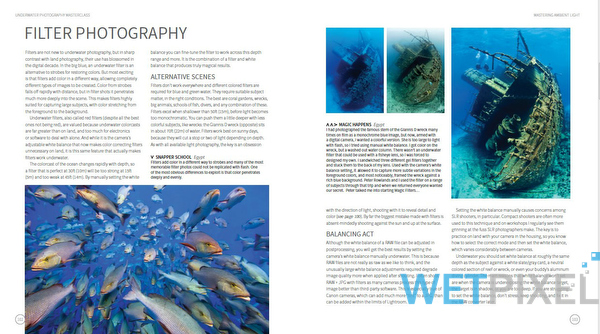
The Underwater Photography Masterclass is designed to be used in the field. It is of a size, weight and binding type that does not create too onerous a burden for the traveling photographer. Inevitably, there will be a significant demand for an electronic version. Alex tells me that the publisher’s plans to release one are still to be confirmed so watch this space.
The Underwater Photography Masterclass will be available shortly from most underwater imaging specialist retailers. It will also be for sale on Amazon and other online book sellers. For more information, please visit the book’s website.
FTC Disclosure:
The reviewer was provided with an early copy of the book for review purposes. The reviewer was also involved in proof reading some sections of the book prior to publishing. Many thanks to Alex Mustard and Paul Eckersley for their help in getting an early copy.